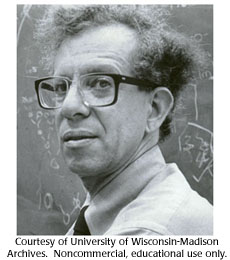Concept 25 Some viruses store genetic information in RNA.

 David Baltimore, Howard Temin and Renato Dulbecco shared the 1975 Nobel Prize in Physiology or Medicine for the discoveries concerning the interaction between tumor viruses and the genetic material of the cell.
David Baltimore, Howard Temin and Renato Dulbecco shared the 1975 Nobel Prize in Physiology or Medicine for the discoveries concerning the interaction between tumor viruses and the genetic material of the cell.
- Go to:
- David Baltimore (1938-2025)
Howard Martin Temin (1934-1994)

Howard Temin was born in Philadelphia. His father was an attorney and his mother was involved in educational civic affairs. Temin was interested in biology and during high school, he was accepted into the summer research program at Jackson Memorial Laboratory in Bar Harbor, Maine. Temin spent four summers there learning about the world of biological research.
After high school, Temin went to Swarthmore College and majored in biology. In 1955, he went to graduate school at the California Institute of Technology. Although he started in biology, he became more interested in animal virology. His doctorate thesis was on work done on Rous sarcoma virus in Renato Dulbecco's laboratory. After his Ph.D. in 1959, he stayed in Dulbecco's lab for another year as a postdoctoral fellow. During this time, he developed his provirus theory, which hypothesized that RSV and other RNA viruses entered the cell and then made DNA copies of themselves before integrating into the host genome.
In 1960, he was offered an assistant professorship at the University of Wisconsin-Madison. During the next four years in his basement laboratory, Temin performed the experiments that proved his provirus theory. He published his results in 1964 and in 1975 shared the Nobel Prize in Physiology or Medicine with David Baltimore and Renato Dulbecco for their discoveries concerning the interaction between tumor viruses and the genetic material of the cell.
Temin stayed at the University of Wisconsin-Madison and eventually became a full professor. In 1974 he also became an American Cancer Society Professor of Viral Oncology and Cell Biology. He was also on the editorial boards of several journals: Journal of Virology, Journal of Cellular Physiology, and Proceedings of the National Academy of Sciences.
Temin was a well-recognized figure around the University of Wisconsin-Madison campus. He walked or biked to and from work everyday along the same path following the lakeshore. In 1998, the University dedicated the Howard Temin Lakeshore Path in his honor.
Although Temin did not smoke, he died in 1994 from lung cancer.


Like many scientists, David Baltimore and Howard Temin started their science careers early. They both participated in high school programs that allowed them to work in a research laboratory for the summer.

Reverse transcriptase is a very useful enzyme for molecular biologists. Can you think of ways reverse transcriptase can be used to clone genes?
 DNA and proteins are key molecules of the cell nucleus.
DNA and proteins are key molecules of the cell nucleus. One gene makes one protein.
One gene makes one protein. A gene is made of DNA.
A gene is made of DNA. Bacteria and viruses have DNA too.
Bacteria and viruses have DNA too. The DNA molecule is shaped like a twisted ladder.
The DNA molecule is shaped like a twisted ladder. A half DNA ladder is a template for copying the whole.
A half DNA ladder is a template for copying the whole. RNA is an intermediary between DNA and protein.
RNA is an intermediary between DNA and protein. DNA words are three letters long.
DNA words are three letters long. A gene is a discrete sequence of DNA nucleotides.
A gene is a discrete sequence of DNA nucleotides. The RNA message is sometimes edited.
The RNA message is sometimes edited. Some viruses store genetic information in RNA.
Some viruses store genetic information in RNA. RNA was the first genetic molecule.
RNA was the first genetic molecule. Mutations are changes in genetic information.
Mutations are changes in genetic information. Some types of mutations are automatically repaired.
Some types of mutations are automatically repaired.